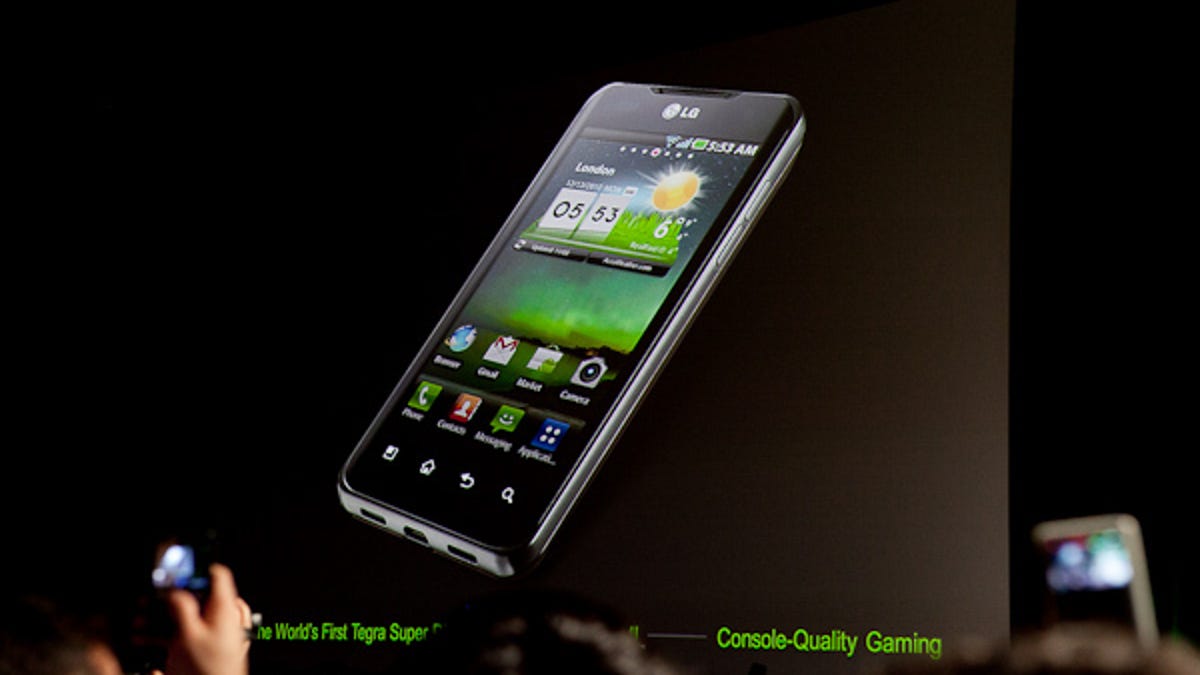LG Optimus 2X is centerpiece of Nvidia CES talk
The new "super phone" is the first to come with a dual-core processor, but there are no plans for a release in the U.S. yet.

Chipmaker Nvidia was giddy about the possibilities of mobile and 3D technologies--two big topics this year at CES 2011--in its keynote address by President and CEO Jen-Hsun Huang at the trade show this afternoon. Among the new additions are its Tegra 2 processor for mobile devices, in-car displays in BMW and Tesla vehicles, and a 3D content-sharing site called 3DVisionLive.
Nvidia's keynote came just hours after rival Intel took the stage to unveil a lineup of desktop and laptop CPUs powered by its new line of "Sandy Bridge" processors, which do not require a separate graphics chip. That's enough for most consumers--something that undoubtedly puts pressure on Nvidia to move into new markets.
Huang's keynote focused primarily upon mobile technologies, like the Iconis Tab tablet computer from Acer, which runs the Android operating system and uses the Tegra 2 dual core 1GHz processor. A series of Tegra 2-related announcements will come out over the course of the week as CES goes on, he said.
The Tegra 2 chip was first announced along with prototypes at last year's CES.
He also announced that the recently-debuted LG Optimus 2X will be the first Tegra 2-enabled "super phone"--a generation beyond the smartphone, he explained. The Optimus 2X, an Android-based which will ship in Korea this month, does not currently have concrete plans to be available in the U.S.
It's the first smartphone with a dual-core processor; other specs of the Optimus 2X include an 8-megapixel camera, a 1.3-megapixel front-facing camera for video calls, a 4-inch WVGA screen, 8GB of internal memory (up to 32GB with microSD), an HDMI connection so it can be hooked up to a monitor, DLNA support, an accelerometer, a gyro sensor, and 1080p MPEG-4/H.264 playback and recording. In the Nvidia press conference, the phone was hyped as being able to handle console-quality gaming. Nvidia also partnered with Adobe to enable Flash technology on the phone--but there regrettably did not seem to be enough bandwidth in the packed ballroom to make a demonstration work.
Regardless, the partnership is a big deal for Adobe, whose CEO Shantanu Narayen joined Huang onstage to talk about it. Flash's place in the mobile world has been thrown into question because of Apple's decision to block it from its iOS mobile operating system. Narayen said that the amount of Flash content on the Web has doubled in the past two years and that as a result, the device world would do well to support it as more and more Web browsing shifts to mobile handsets and tablets.
Huang did manage to demonstrate the wildly popular game Angry Birds on the LG Optimus 2X to show off its graphics capabilities--as well as Dungeon Defender, a role-playing game that because of the Tegra 2 processor can be played on mobile devices as well as traditional consoles.
Also there to hype up the Tegra 2 was Verizon Wireless vice president Kyle Malady, who said that the faster processor speeds will be a boon to the Verizon 4G wireless technology that seems to be everywhere at CES this year.
And Nvidia concluded with one big, shadowy swipe at Intel: "Project Denver," an Nvidia partnership with ARM to build a high-performance processor for supercomputing. Huang called it "a new era in computing"--but kept mum beyond that.

